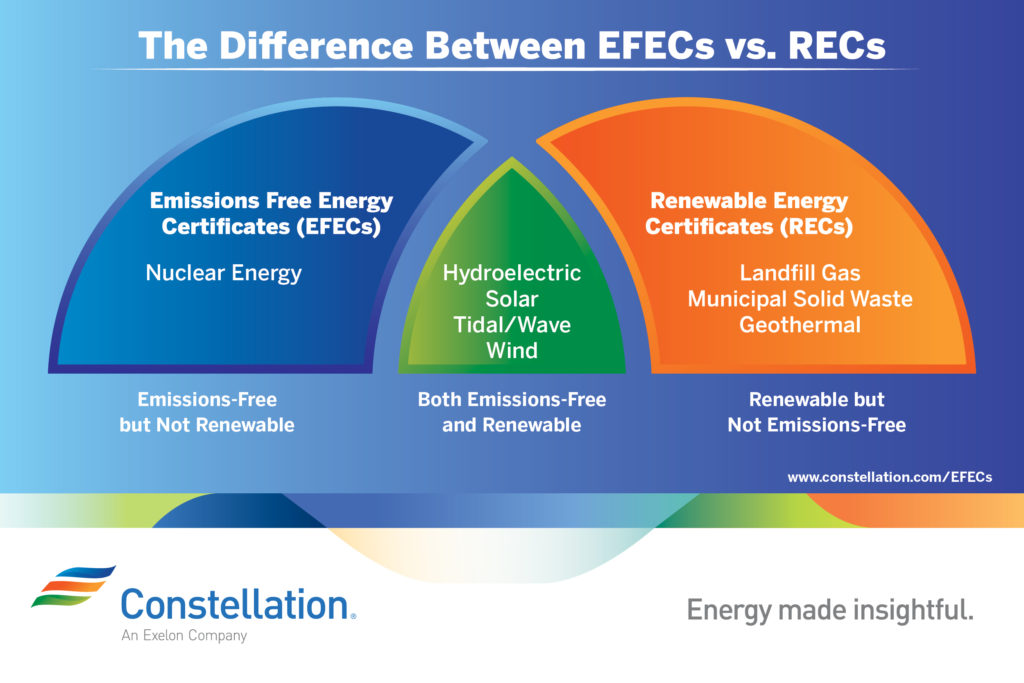How Emission-Free Energy Certificates (EFECs) Help Companies Achieve their Carbon Goals
Sustainability continues to be top of mind for energy managers. To develop a strategic plan, they must first determine their budget and carbon reduction goals. With the help of an energy supplier, businesses can navigate the energy solutions that are available to them that meet these requisites.
Emission-Free Energy Certificates (EFECs) are one option, and an alternative to renewable energy purchases, that allow businesses to quickly begin their process towards achieving and claiming lower emissions. This is an especially effective solution for –
- Organizations that are not well-positioned to source their power from onsite renewable sources based on land or capital limitations
- Companies that do not have a specific sustainability roadmap established but want to communicate their incremental efforts and impacts
When purchased alongside electricity, EFECs guarantee that equivalent energy was created from emission-free sources. By purchasing EFECs, customers take the emission-free attributes that can come from several generating sources, like nuclear, solar, wind, hydropower and more, that do not emit greenhouse gases from combustion. However, most of the time, EFECs sold in the voluntary market are associated with nuclear or large-scale hydroelectric generation.
When weighing EFECs as an option for reaching sustainability goals, customers should: 1) consider whether their sustainability focus is on renewables or emissions, 2) understand emissions accounting and what energy claims can be made with EFECs, and 3) understand the growing importance of EFECs in the overall grid rate.
1. Delineating between renewable and zero-emissions goals.
Goals focused on being entirely renewable and on being emission-free both have their merits, but they are not the same. Renewable energy certificates (RECs) track the renewable and zero-carbon attributes associated with renewable generation, whereas EFECs track the zero-carbon generation attributes associated with emission-free generation, which can include, but is not limited to, renewable generation (e.g., nuclear, solar, wind, hydropower, etc).
The purpose of an EFEC is to support zero-carbon electric generation on the grid. Some REC sources like biomass and resource recovery have associated emissions and therefore cannot be labeled as emission free; however, renewables with zero emissions can generate EFECs. But not all EFECs (such as nuclear) are generated by renewable sources.

2. Understanding emissions accounting and the claims that customers can make with EFECs.
The World Resource Institute creates the greenhouse gas reporting standard that most companies use to account for their emissions, including emissions associated with purchased electricity, also known as “Scope 2” emissions. This guidance includes location and market-based accounting. All generation tracked throughout the market is provided certificates, whether renewable, emission-free or other emissions rates. As customers buy and sell these attributes, they can make associated renewable or emissions claims related to their energy use. For example, after purchasing an EFEC, a customer could promote their emission-free efforts as:
- Supporting demand for generation sources that do not directly emit greenhouse gases.
- Demonstrating support of energy generation that produces little to no emissions.
- Showing commitment to operate without adding to pollution.
EFECs are interchangeable substitutes for RECs in greenhouse gas emissions accounting, because zero carbon holds the same weight across both options. If zero carbon is a customer’s main goal, EFECs may be the more cost-effective option.
3. Highlighting the importance of EFECs in the overall grid rate.
In 2019, 36 percent of electric came from zero-carbon generation, of which only 45 percent of which was renewable (e.g., solar, wind or hydroelectric).1 As we strive to reduce emissions from all electric generation, it is important to not just encourage new renewables but also maintain the existing zero-carbon generation, so that supply increases year over year. Several states have started to recognize the importance of emission-free energy as essential to sustaining lower grid emissions rates. New York, Illinois and New Jersey have all added nuclear power zero-emission credits to their clean power regulations. If a customer is not limited to only renewable technologies, using EFECs to support their goals can support all zero-carbon technologies that keep the overall emissions rate of the electric grid lower and achieve broader decarbonization goals.
All of these factors should be considered by energy buyers to ensure the credits they purchase are aligned with their defined sustainability goals. Constellation can help bring order to the chaos of environmental goals and reporting by providing emission-free options to your electricity supply and helping you to promote the benefits they may provide.
*This blog post is a part of our “Supplier to Strategist: A Blog Series on Sustainability, Efficiency and Technology” where we will provide the framework for customers on how to develop and achieve their long-term sustainability strategy and goals, and understand the innovative management products and solutions that can make a direct impact on their bottom line.
Source
Based on current World Resources Institute (WRI) guidance. Scope 2 reporting claims of this product may be affected by future changes.

